JABIL CIRCUIT D1598D1598-8 BTGPS II Trine (Bluetooth GPS Receiver) User Manual Manual
Jabil Circuit Taiwan Limited BTGPS II Trine (Bluetooth GPS Receiver) Manual
Manual

CRUX II / BTGPSTM
GPS Receiver
User Guide
Model number: D1598
D1598-8
2
v.2
3
Copyright © EMTAC 2002. All rights reserved.
Reproduction, transfer, distribution or storage of part or all of the contents in this
document in any form without the prior written permission of EMTAC is prohibited.
The Bluetooth trademarks are owned by Bluetooth SIG, Inc. USA.
Other products and
company names mentioned herein may be trademarks or
tradenames of their respective owners.
EMTAC reserves the right to make changes and improvements to any of the products
described in this document without prior notice.
Under no circumstances shall EMTA
C be responsible for any loss of data or income or
any special, incidental, consequential, or indirect damages howsoever caused.
4
Warnings
Care and Caution
The Global Positioning System (GPS) is operated by the United States
Government which is solely responsible for the accuracy and continued operation
of the system. Accuracy of position fixes (longitude, latitude and altitude) can be
affected by alterations made to the GPS satellites by the U.S. Government.
Accuracy is subject to change in accordance with the U.S. Department of
Defense civil GPS user policy and Federal Radionavigation Plan. Positional
accuracy and time to fix time can also be affected by poor view of caused by
obstructions such as
tall buildings,
heavy foliage,
large cliffs and other obstructions
where GPS satellite signals are blocked and poor satellites geometry conditions
result.
Judgment
CRUXII / BTGPSTM receiver is an excellent navigation and location awareness
assist tool, but does not substitute the needs of careful steering and good
judgment. Never only rely on one single tool or apparatus for positioning and
navigation.
Accessories
The accessory supplied with the CRUX II / BTGPS receiver is specifically designed for
BTGPS. Use of other accessory may severely degrade performance or even damage the
receiver, and will void the warranty. Make sure using the charger by EMTAC. DO NOT
USE OTHER CHARGER. Do not try to open or break the receiver. There is no
service accessory part inside the receiver. Open the receiver will void the
warranty.
Software
Follow the operation guidance as stated and described in the user guide of the
GPS application software.
The software supplied in and with the CRUX II / BTGPS receiver is solely for
personal usage. Making copies only for personal use, but may not copy, modify,
reverse engineer or transfer the software unless
expressively provided by written
agreement. The software is the property of EMTAC and/or its supplier and is

5
protected by international treaty provisions.
Safety
THE CRUX II / BTGPS contains Lithium-ion battery inside. Leaving the CRUX II /
BTGPS in hot or cold conditions, such as in a closed car in summer or
winter conditions,
will reduce the capacity and lifetime of the battery inside. Always try to keep the CRUX
II / BTGPS between +15°C (+59°F) and +25°C (+77°F). A CRUX II / BTGPS with a hot
or cold battery may temporarily not work, even when the battery is fully charged. The
performance of Lithium-ion batteries is particularly limited in temperatures below 0°C
(+32°F). Temperature extremes will affect the ability of your battery to charge: allow
the CRUX II / BTGPS to cool down or warm up first.
Batteries must be recycled or disposed of properly. Batteries must not be disposed of in
municipal waste.
DO NOT DISPOSE OF THE CRUX II / BTGPS RECEIVER IN A FIRE!
Charge the CRUX II / BTGPS only with the charger supplied with. When a charger is not
in use, disconnect it from the power source. Do not leave the CRUX II /BTGPS
connected to a charger for longer than 24 hours, since excessive charging may shorten
its life. If left unused, a fully charged battery will discharge itself over time.
CAUTION
RISK OF EXPLOSION IF BATTERY IS REPLACED
BY AN INCORRECT TYPE.
DISPOSE OF USED BATTERIES ACCORDING
TO THE INSTRUCTIONS.
To assure product safety
, the battery maker requests following statements in the
instruction manual/User Guide of the equipment.
Danger
u When charging the battery, use dedicated chargers and following the specified
condition.
u Use the battery only in the specified equipment.

6
u Don’t connect battery directly to an electric outlet or cigarette lighter charger.
u Don’t heat or throw battery into a fire.
u Don’t use, leave battery close to fire inside of a car where temperature may be over
60°C. Also don’t charge/discharge in such condition.
u Don’t immerse, throw, wet battery in water / seawater.
u Don’t put batteries in your pockets or a bag together with metal objects such as
necklaces, hairpins, coins, or screws. Don’t store batteries with such object.
u Don’t short circuit the (+) and (-) terminals with other metals.
u Don’t place battery in a device with the (+) and (-) in the wrong way around.
u Don’t pierce battery with a sharp object such as a needle, etc.
u Don’t hit with a hammer, step on a throw or drop to cause strong shock.
u Don’t disassemble or modify the battery.
u Don’t solder a battery directly.
u Don’t use a battery with serious scar or deformation.
u Don’t use battery in a corrosion environment (damage from salt water, sea water,
acid, alkali, corrosion gas, etc.).
Warning
u Don’t put battery into a microwave oven, dryer, or high-pressure container.
u Don’t use battery with dry cells and other primary batteries, or batteries of a
different package, type, or brand.
u Stop charging the battery if charging isn’t completed within the specified time.
u Stop using the battery if abnormal heat, order, discoloration, deformation, or
abnormal condition is detected during use, charge, or storage.
u Keep away from fire immediately when leakage or foul orders are detected.
u If liquid leaks onto your skin or cloths, wash well with fresh water immediately.
u If liquid leaking from the battery gets into your eyes, don’t rub your eyes.
u Wash them well with clean water and go to see a doctor immediately.
Caution
u Store batteries out of reach of children so that they are not accidentally swallowed.
u Before using the battery, be sure to read the user’s manual and conditions on
handling thoroughly.
u Thoroughly read the user’s manual for the charger before charging the battery.
u For information on installing and removing from equipment, thoroughly read user’s
manual for the specific equipment.
u Batteries have life cycles. If the time that the battery powers equipment becomes
much shorter than usual, the battery life is at an end. Replace the battery with a
new same one.
u Remove a battery whose life cycle has expired from equipment immediately.
7
u When the battery is thrown away, be sure it is non-conduction by applying vinyl
type to the (+) and (-) terminals.
u When not using battery for an expanded period, remove it from the equipment and
store in a place with low humidity and low temperature.
u
While the battery is charged, used and stored, keep it away from object or materials
with static electric chargers.
u If the terminals of the battery become dirty, wipe with a dry cloth before using the
battery.
Notice
In order to help you fulfilling any warranty obligations, read comprehensively the
“Warnings”, “Disclaimer and Limitation of Liability”, “Basic Guidelines”, “Care and
Maintenance”, and the whole User Guide.
8
Disclaimer and Limitation of Liability
EMTAC and its subsidiaries assume no responsibility for any damage or loss resulting
from the use of this product, software and user guide.
EMTAC and its subsidiaries assume no responsibility for any loss or claims by third
parties which may arise through the use of the software. EMTAC and its subsidiaries
assume no responsibility for any damage or loss caused by deletion of data as a result
of malfunction, dead battery, or repairs. Under no circumstances shall EMTAC and its
subsidiaries are responsible for any loss of data or income or any special, incidental,
consequential or indirect damages howsoever caused.
The contents of this User Guide are provided “as it”. Except as required by applicable
laws, no warranties of any kind, either express or implied, including, but not limited to,
the implied warranties of merchantability and fitness for a particular purpose, are made
in relation to the accuracy, reliability or contents of this user guide. EMTAC reserves the
right to revise this user guide or withdraw it at any time without prior notice. EMTAC
reserves the right to make changes and improvements to any of the products described
in this user guide.
9
Table of contents
Basic Guidelines 9
Getting Start 11
Introduction 11
Prepare to use your BTGPS 12
GPS signal reception 12
Using optional external active antenna 13
CAUTION AND WARNING 14
General Information 15
General Features 15
Antennae Façade 17
Power Switch 17
External Antenna Port 18
LED indicators 18
Power Jack 18
External active antenna (optional) 19
Operation Guide 20
Step 1 To install the GPS/MAP application software 21
Step 2 To pair/connect the BTGPS with the host 22
Step 3 To operate the GPS/MAP application software 24
Step 4 To connect with the external active antenna (optional) 25
Indication of BTGPS operation 26
To charge the battery of the BTGPS 27
Troubleshooting 28
Care and Maintenance 29
Glossary 30
10
Basic Guidelines
SAFETY
Read the User Guide and these basic guidelines comprehensively. Breaching the
regulations and rules may be dangerous or illegal. Road safety is the first priority; do
not use or operate the CRUX II / BTGPSTM receiver while driving. Keep the CRUX II /
BTGPS receiver away from high temperatures and fire. Additional detailed information
is given in this user guide.(see mare details in “Warning” section)
PROPER HANDLING
Operating the GPS receiver requires a clear and unobstructed view of sky with the
antenna facade pointing upward to the sky. Do not bend CRUX II / BTGPS receiver
while connected to charger, bending will damage the connector, resulting in damage to
the BTGPS or the charger’s plug.
FIRST TIME OPERATION
A longer than normal time-to-first-fix of position may result the first time you use the
CRUX II / BTGPS. Follow this user guide and consult the instructions of the host
platform and GPS application software.
INTERFERENCE
GPS receivers may receive interference near cellular base-station and when in close
proximity to mobile phone antennas. This interference may affect positioning and
time-to-fix performance.
CONNECTOR and JACK
The CRUX II / BTGPS has one external antenna (port) connector, and one DC power
jack. Caution and care must be exercised w
hen handling these parts. Bending or
breaking these parts will severely degrade positioning performance and
damage
the receiver. This will void your warranty.
ACCESSORIES*
Use only manufacturer approved accessories with the CRUX II / BTGPS. No service part
inside the CRUX II / BTGPS receiver.
SERVICE
Only qualified engineering service personnel must install or repair equipment.
*The external active antenna is an optional accessory which not included in the standard package.
11
SWITCH OFF
Obey all laws, regulations, rules and restrictions. Switch off the host platform and
discontinue operation of the CRUX II / BTGPS receiver in hospital ICU, aircraft, gasoline
station, near fuel or chemical, near blasting area, or other restricted areas.
NOTICE
Read the “Warnings” section comprehensively before operation.
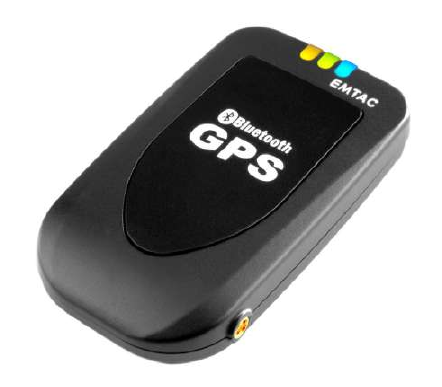
12
1. Getting Start
Introduction
Congratulations on purchasing the CRUX II / BTGPSTM. This GPS receiver is the world
first mobile GPS receiver integrated with Bluetooth technology. The BTGPS offers
flexible and various location awareness applications for both consumer and corporate
usages including
● Navigation and Positioning
● Find Street and Route
● Travel Route Planning
● Recreation
● Safety and Security
● Fleet Management
● Logistic
● Field-Force Management
● Enterprise Location Service (ELS)
● Location-Based Service (LBS)
● Mobile Location Service (MLS)
Figure 1
13
Prepare to use you CRUX II / BTGPS Receiver
To help you begin to use your CRUX II / BTGPSTM Receiver (“BTGPS”), read this User
Guide in the first step. This User Guide explains the detail how BTGPS operates,
functions, and common features of the BTGPS. A short glossary of GPS related terms
and abbreviations at the back of the User Guide.
Before you begin using your BTGPS, you must complete the application software
installation tasks on your host device like PAD, PDA mobile phone, MMS mobile phone,
handheld PC, and portable PC hardware. For information about the hardware operation
and application software installation, please refer to the documentation that
accompanies each product.
For operation detail information, please consult Chapter 3. In order to get more familiar
with your BTGPS, please first read Chapter 2 before starting to operate BTGPS.
GPS signal reception
The Global Positioning System (GPS) is a space-based radio-navigation system. This
system consists of 24 satellites, which orbit the Earth at an altitude of approximately
17,500 kilometers, and ground control stations. Each of the 24 satellites, deployed in 6
orbital planes, circles the earth twice a day. The system satellites continuously transmit
signals contain the information of time and distance in a precise formation, 24 hours a
day in any weather condition, everywhere around the world. By processing the signals
received, BTGPS provides users with helpful information of position, velocity, and time
for navigation and location awareness purposes anywhere anytime on the Earth.
The BTGPS offers high position accuracy and fast Time-To-First-Fix (TTFF), which rely
on environment circumstances where receiver located as well as initial states of the
receiver. During attempting to a position fix, the receiver needs to lock on to at least 3
satellites and, uses the signal can be received as well as the data of latest position
stored in the receiver’s digital memory in order to compute the location of the device.
Environmental factors that influence the position accuracy and TTFF including such as
tall buildings,
narrow street and passageway,
protection film on glass,
14
heavy foliage,
large cliffs,
and other obstructions where the satellite signals may blocked, and, poor satellites
geometry situation. Initial state of the receiver, means latest status in memory of the
receiver, may mainly determine the time of TTFF. Position can be quickly fixed within
only 10 seconds from a hot-start state and needs 80 seconds typically from a cold-
start
state. Or, might need at least 3 to 5 minutes from a completely restart-state, for
example, flying a distance over 500 kilometers from initial origin.
BTGPS uses the satellite signals to calculate an exact geodetic location through
triangulation method, contained in 10 meters CEP accurateness devoid of Selective
Availability (SA), which is good enough for general location awareness purposes. The
position data is then converted within the receiver to latitude and longitude coordinates,
which is usually provided in the geodetic datum on which GPS is based (WGS 84).
Position offsets of hundreds of meters or much more can result from using the wrong
datum.
In addition to datum used, there are
number of positioning errors can occur, limiting
accuracy. The major errors including satellites
orbiting error, poor satellites geometry,
multi-path signals, atmospheric delay and receiver clock timing.
The indication of GPS signal reception is described in section “
Indication of BTGPS
operation” of Chapter 3.
Using optional external active antenna*
Your BTGPS is optional equipped with an external active antenna* for convenience
usage when operating under certain environment situation, such inside vehicle where
satellite signals are blocked. Detailed operation is described in Operation chapter. Make
sure using the optional external antenna* supplied by EMTAC. Use of unqualified
antenna will severely degrade positioning performance or even damage the receiver.
Read basic guidelines before using external active antenna accessory.
*The external active antenna is an optional accessory which not included in the standard package.
CAUTION and WARNING
The BTGPS contains a rechargeable Li-
ion battery which supplies the power for the
operation of GPS and Bluetooth circuits inside. Care and caution must take
into account
15
are:
l
Only use the charger supplied with the BTGPS. Use other charger can damage the
BTGPS and even dangerous at the risk of explosion.
l Do not expose BTGPS to high temperatures higher than 60°C (140°
F) such in car
under direct sunshine. Expose BTGPS to high temperatures environment
can not
only shorten the life of electronic devices and melt or drape
certain plastics, but
also can damage
the battery inside the BTGPS and even dangerous at the risk of
explosion.
l Do not try to open or break the
receiver. There is no service accessory part inside
the receiver. Open the receiver will void the warranty.
16
2. General Information
This chapter describes your BTGPS in details.
General features
Your BTGPS is an excellent navigation and positioning aid tool when using with mobile
terminal devices(“host”) of Bluetooth enabled, which the host with GPS application
software installed. The general features are
■ Best mobile GPS receiver for consumer and corporate
■ GPS receiver with Bluetooth transceiver built-in
■ Provides fully interoperability with Bluetooth integrated mobile devices
■ Ultra-low power consumption with Li-ion rechargeable battery built-in
■ Long operation time: 8 hours under continuous mode
■ LED lights indicate GPS status, Bluetooth connection and battery condition
■ Embedded high sensitivity GPS active antenna and Bluetooth antenna
■ External GPS active antenna(optional) for in vehicle and indoors use
■ Compatible with all GPS map running on various hardware platforms
■ Navigating freely without wire connection to host mobile devices-- true wire-less
In the following sections, each portion details of BTGPS are described
, see Figure 2 and
3.
Portion details:
Antenna Façade
Power Switch
External Antenna Port
LED indicators
Power Jack
External Active Antenna (optional)
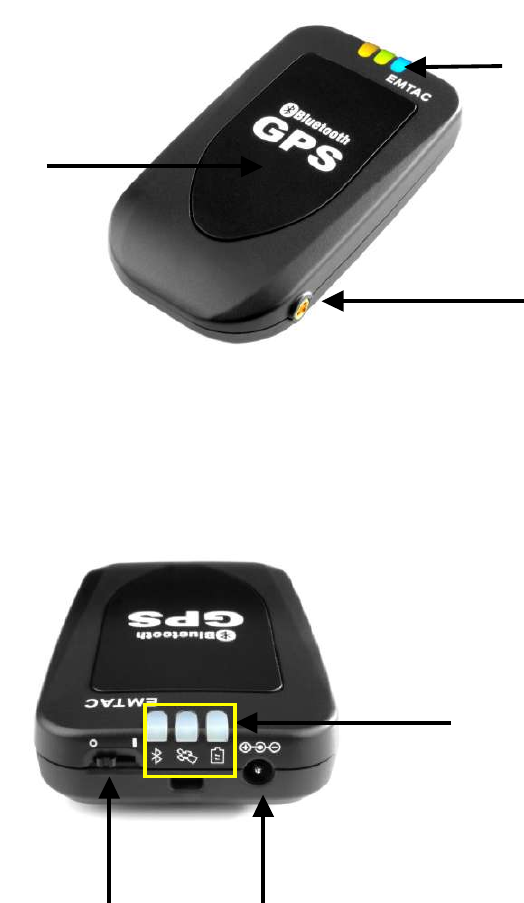
17
A: Antenna Facade
B: Power Switch
C: External Antenna Port
D: LED Indicators
E: Power Jack
Figure 2
B
D
E
A
C
D
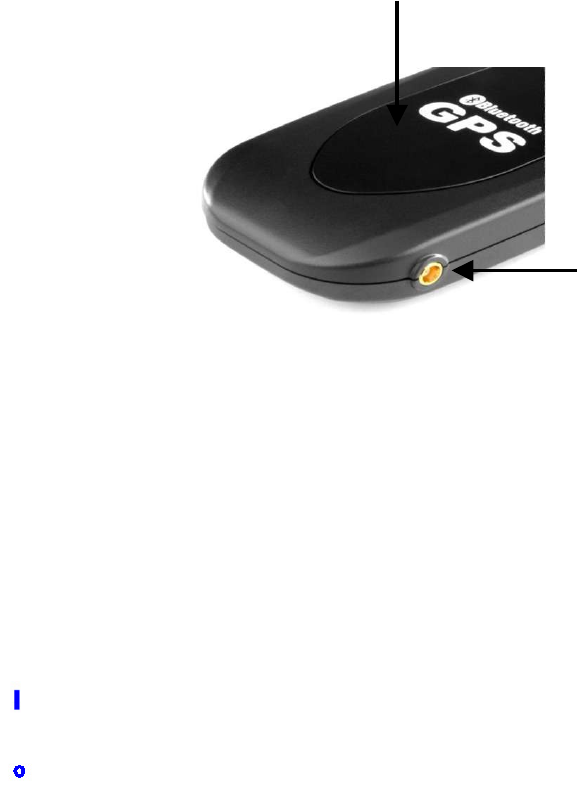
18
Antennae Facade
Your BTGPS integrated with a high sensitive 1.5GHz GPS antenna and 2.4GHz Bl
uetooth
antenna internally, which can offer good satellite signal reception for position fix as well
as data communication between BTGPS and your Bluetooth host terminal, respectively.
The antenna facade area is top surface of the BTGPS, as indicated Figure 2 and 3. Keep
this surface clean and clear view to the sky while operating GTGPS. Do not let this
frontage surface area covered fully or partially by any object especially contains metal
and/or electromagnetic wave absorption materials such as screwdriver, pen, watch,
floppy diskette, CD and metal wires, thin metal foil like aluminum foil and metal-coated
plastic bag, water or liquid, and carbon paper. While operation, sometimes even in
non-operation state.
Figure 3
Power Switch
The Power Switch is indicated as “B” in Figure 2.
Symbol: Power-on position of the Power Switch.
Symbol: Power-off position of the Power Switch.
Antennae Facade Area
External Antenna Port
(MCX type)

19
External Antenna Port
Your BTGPS is equipped with a RF connector port (MCX type) for connecting with
external active antenna(optional accessory) when operating under certain environment
situation, such as inside a vehicle and where satellite signals are blocked or obstructed.
The external antenna port is indicated as “C” in Figure 2. Make sure using the external
antenna(optional accessory) supplied by EMTAC. Use of other active antenna will
severely degrade positioning performance or even damage the receiver. Please read
basic guidelines before using the external active antenna accessory.
LED Indicators
In Figure 2, three LED lights indicate the operation status of Bluetooth
(BLUE),
GPS(GREEN) and Battery(YELLOW/RED) of the BTGPS.
Symbol: Blue LED Light indicates Bluetooth pair/connect status
Flashing every 1 second: BTGPS just power-on and waiting for pair/connection.
Flashing every 2 seconds: BTGPS is connected and paired with the host.
Symbol: Green LED Light indicates GPS status
Constant on: When BTGPS just power on, attempting to fix a position.
Flashing: BTGPS has a position fixed.
Symbol: Yellow/Red LED Light indicates Battery status
Red light constant on: Battery low.
Yellow light constant on: Battery under charging.
No light (off): Battery fully charged
Power Jack
When the Red LED light is constant on, you need to charge the Li-ion battery inside the
BTGPS by plugging the charger’s plug into the power jack which indicated as “E” in
Figure 2. Make sure using the charger supplied with the BTGPS. DO NOT USE OTHER
CHARGER to charge the BTGPS.
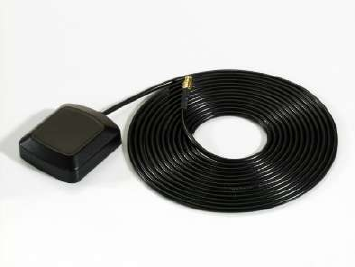
20
External active antenna (optional)
The external active antenna is an optional accessory. Just connecting the external
active antenna to the external antenna port described in previous section “External
Antenna Port”. The active antenna is embedded magnet in the bottom for easy
mounting on metal surface, be caution not put near to materials are sensitive to
magnetic field, such as magnetic storage media like floppy diskette. Figure 4 is the
reference photo of the optional external active antenna. Make sure using the external
antenna supplied by EMTAC. Use of other active antenna will severely degrade
positioning performance or even damage the receiver.
Figure 4
21
3. Operation Guide
Before using the BTGPS, first make sure to prepare following steps are ready for
operation.
■ The GPS application software is correctly installed in the host platform(s)
■ The BTGPS is fully power charged
■ Check the Bluetooth is ON in the host
■ Identify the operation environment whether external antenna needed or not
For information about the operation of the host and GPS application software
installation procedures, please refer to the documentation that accompanies each
product, respectively.
In this Chapter, a step-by-step operation procedure is described.
Step-1 To install the GPS/MAP application software
Step-2 To pair/connect the BTGPS with the host
Step-3 To operate the GPS/MAP application software
Step-4 To connect with the external active antenna(optional)
Indication of BTGPS operation
To Charge the battery of the BTGPS
22
Step 1 To install the GPS/MAP application software
Before operation the BTGPS, make sure the GPS/MAP application software is properly
and completely installed in the host platform.
To install the GPS/MAP application software, please consult and follow the operation
guide described in
the user guide of the GPS/MAP application software. Make sure the
GPS/MAP application installed completely.
In this User Guide CD-ROM, there is the “Crux_Viiew Test Program”
(trial version) for
testing purpose. Please follow the step-by-step operation gu
ide indicated and described
in the CRUX_VIEW(Trial) Manual file(in .pdf format).
Note:
(a)
The Crux_View Test Program is a trial version program and only for testing
purpose.
(b)
The Crux_View program is only for BTGPS used with PocketPC(PPC) PDA with
Bluetooth enabled.
(c) Current version of Crux_View supports ARM(StrongARM/X Scale) based PPC.
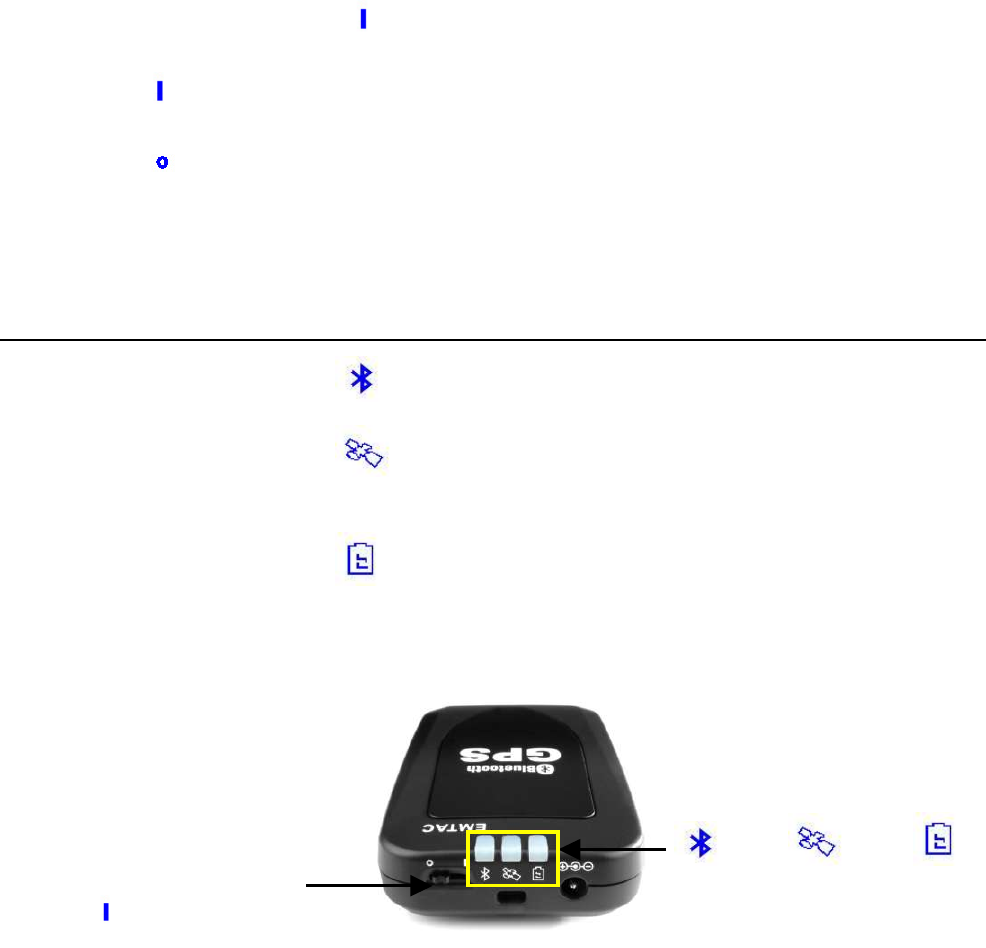
23
Step 2 To pair/connect the BTGPS with the host
To pair and connect your BTGPS with the host platform, please consult and follow the
operation guide described in the user guide(operation manual) of the host or PDA.
First, turn on the power of host and BTGPS, respectively.
► Turn on the power of the host and ready.
► Turn on the power of the BTGPS, the power switch is indicated as “B” in Figure 2.
(Make sure the battery of the BTGPS is fully charged.)
Turn the power switch to position.
Symbol: Power-on position of the Power Switch.
Symbol: Power-off position of the Power Switch.
Once the BTGPS is just power-on and before pair/connection and operation:
LED Indicator Symbol Status Indication
BLUE (left) Flashing every one(1) second
GREEN Constant on(before a position fixed)
(middle) (Flashing if has a position fixed)
YELLOW/RED No light (if fully charged)
(right)
Figure 5
Switch to power-on
position:
“
”
Status LED Indicators:
Blue Green Yellow/Red
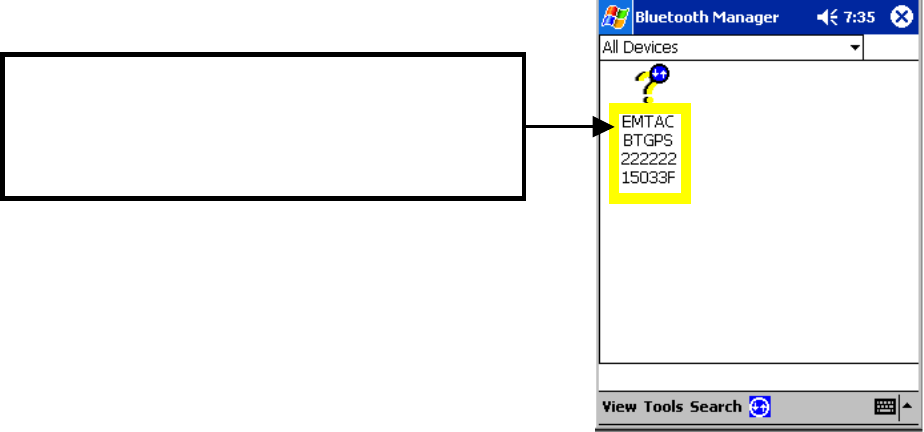
24
NOTE:
Typical examples are given in the .pdf files named “BTpair_” (and/or similar files), in
this User Guide CD-ROM. Please follow the step-by-step operation guide indicated and
described in the files, respectively. Figure 6 is an example indicates that BTGPS
already connected with your PDA.
Figure 6
Example:
This screen-shot indicates the BTGPS is
connects with host.
25
Step-3 To operate the GPS/MAP application software
To open and use the GPS/MAP application, in your PDA:
■ Make sure your BTGPS is connected with the host via Bluetooth
■ Open the GPS/MAP application on the host
■ Enter into the GPS/Map application operation
You can easily use all the functions of GPS/MAP application software by following the
details operation guidance described in the user guide of the GPS/MAP application
software.
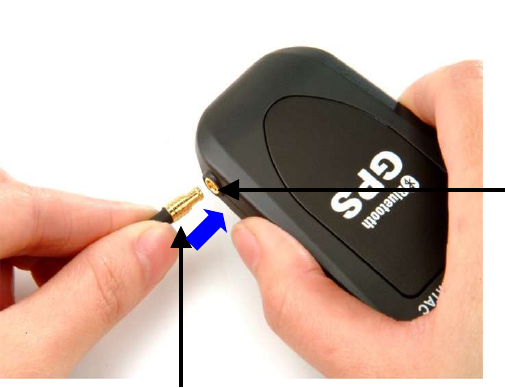
26
Step-4 To connect with external active antenna(optional)
When operating under the condition that satellite signals are obstructed or blocked
such as inside vehicle. First, locate the external antenna port (MCX female) and then
plug the connector (MCX male) of external active antenna(optional accessory) into the
external antenna port, as indicated in Figure 7. Put the external active antenna on the
roof metal surface of the car, or on the front top-surface of the dash board where are
not affect driving safety and appropriated. Use only the active antenna(optional)
supplied by EMTAC. Use of other
antenna will severely degrade positioning performance
or even damage the receiver. Read “Basic Guidelines” before using external active
antenna accessory.
Figure 7
Connect and install the optional external active antenna in position before driving. Do
not operate the optional external antenna while steering on the road. The optional
active antenna is embedded magnet in its bottom for easy mounting on metal surface,
be caution not put near to materials are sensitive to magnetic field, such as magnetic
storage media like floppy diskette and mechanical wrist watch.
External Antenna Port
(MCX-type/female)
Connector of the optional External Active Antenna
(MCX-type/male)

27
Indication of BTGPS operation status
In Figure 2 and 5, three LEDs indicate the operation status of Bluetooth
(BLUE),
GPS(GREEN) and Battery(YELLOW/RED) of the BTGPS, described in followings.
Symbol: Blue LED Light indicates Bluetooth pair/connect status
Flashing every 1 second- BTGPS just power-on and waiting for pair/connection.
Flashing every 2 seconds- BTGPS is connected and paired with the host.
Symbol: Green LED Light indicates GPS status
Constant on: When BTGPS just power on, attempting to fix a position.
Flashing: BTGPS has a position fixed.
Symbol: Yellow/Red LED Light indicates Battery status
Red light constant on: Battery low.
Yellow light constant on: Battery under charging.
No light (light off): Battery fully charged
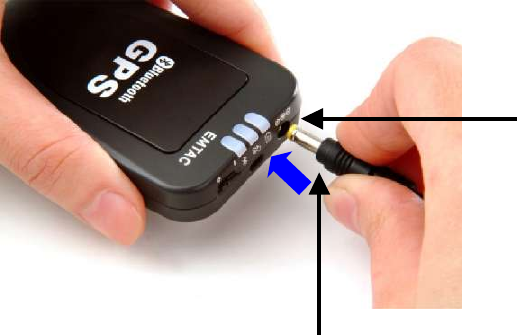
28
To charge the battery of the BTGPS
When the Red LED light is light on, you need to charge the Li-ion battery inside the
BTGPS by plugging the charger’s plug into the power jack which indicated as “E” in
Figure 2. Make sure using the charger supplied with the BTGPS as illustrated in Figure
8.
Figure 8
DO NOT USE OTHER CHARGER TO CHARGE THE BTGPS!
Power Jack
Charger Plug
29
4. Troubleshooting
1. I already pairing the BTGPS with the PDA, but sometimes just can not
connect to the BTGPS.
First, delete the ‘old BTGPS icon’ on your Bluetooth manager software, and
re-searching it again.
2. Can I use the Crux_View for navigation purpose?
No. The Crux_View Test Program is only for evaluation and for testing purpose only, it
is NOT designed for navigation.
3. Which GPS/Map application software I can use?
There are a lot of major application software can be operation on Bluetooth enabled
PDA, such as Mapopolis, OziExplorerCE, Teletype, TomTom, TUMONZ, …etc, which
compatible with BTGPS. Please contact with the Map provider for details.
4. What is the passkey or pin code for the BTGPS paring with the PDA?
Please key-in: 0183. This the passkey or the pin code required.
5. It is possible to charge the battery in the same time use the BTGPS?
Yes. What means you can have a continuous use of the BTGPS.
30
5. Care and Maintenance
Your BTGPS is a sophisticated product of superior design as well as craftsmanship, and
should be treated with care of usage and maintenance. The suggestions below will help
you to fulfill any warranty obligations. When using your BTGPS and the optional
external active antenna:
■ Keep BTGPS and all accessories out of small children’s reach.
■ Keep BTGPS dry. Humidity, liquids
and precipitation contain minerals that will
corrode its connector, jack, plug and electronic circuit boards.
■ Use only the supplied and approved accessories. Unauthorized
accessories, antenna,
modifications or attachments could damage the BTGPS and may violate regulations
governing radio devices.
■
Only use the charger supplied with for charging purpose. Use other charger may
damage the BTGPS and even dangerous at the risk of explosion.
■
Use dry and clean soft cloth to clean the BTGPS. Do not use harsh cleaning solvents,
chemicals or strong detergents.
■
Do not drop, shake or knock the BTGPS. Rough handling can break the connector,
jack and internal electronic circuit boards. Dropping the BTGPS may break the
connector and jack which will cause non-recoverable and malfunction damages.
■ Do not expose to rain or high humidity environment, or
even pour water on it, which
will cause malfunction or non-recoverable damage.
■
Do not sore BTGPS in dusty, dirty areas. Its moving parts, like connector pins and
clips, can be damaged.
■
Do not store BTGPS in hot areas. High temperatures can shorten the life of
electronic devices, and melt or drape certain plastics.
■ Do not expose to high temperatures higher than 60°C (140°
F) such in car under
direct sunshine.
■ Do not store BTGPS in cold areas. When the BTGPS
warms up to its normal
operation temperature, moisture can aggregate inside it, which may severely
damage electronic circuit boards inside.
■ Do not attempt to open the BTGPS. Unauthorized handling may damage the BTGPS.
■
Do not paint on the BTGPS. Paint can clog the connector, jack, and prevent proper
normal operation of the BTGPS.
31
Glossary
Almanac data
A set of information that transmitted by each satellite on the orbits and state of every
satellite in the GPS constellation. Each GPS satellite contains and transmits the almanac
data set for the entire GPS satellite system network. Almanac data allows the GPS
receiver to rapidly acquire satellites shortly after it is turned on.
ACTIVE ANTENNA
An antenna that amplifies the GPS signal before it sends it to the receiver.
Altitude
The distance between the current position and the nearest point on WGS 84 reference
ellipsoid, usually it is expressed in meters or feet and is positive outside the ellipsoid.
Baud
Bits per second. Also referred to as a baud rate.
Channel
Channel refers to a set of hardware in the receiver that detects locks on and
continuously tracks the signal from a single GPS satellite. The more channels available,
the greater number of GPS satellite’s signals a receiver can simultaneously lock and
track. A receiver of 12 channels is the optimized design, considering the current
consumption, chip-package size and cost.
CEP - Circular Error Probable
CEP is the radius of a circle, centered at a true location, within which fifty percent of
positioning solutions fall. CEP is used to achieve horizontal accuracy.
C/No
Carrier-to-Noise density ratio. An indication of satellite signal strength received by the
GPS receiver.
COLD START
A condition in which the GPS receiver can arrive at a navigation solution without initial
position, time, current Ephemeris, and almanac data.
32
Constellation
Constellation refers to the specific set of of orbiting GPS satellites system, used in
calculating positions or all the satellites visible to a GPS receiver at one time. The
pattern created by the relative positioning of a GPS satellite network is designed to
achieve a very high probability of global satellite coverage even in the event of satellite
outages.
dB
Decibel. A notation of relative unit such as the satellite signal strength received.
DATUM
A math model which depicts a part of the surface of the earth. Latitude and longitude
lines on a paper map are referenced to a specific map datum. The map datum selected
on a GPS receiver needs to match the datum listed on the corresponding paper map in
order for the position readings to match.
Elevation mask
Elevation mask is an adjustable feature of GPS receivers that specifies a satellite must
be a certain number of degrees above the horizon before its signals are used for
positioning. Satellites at low elevation angles (five degrees or less) have lower signal
strengths and are more prone to loss of lock thus causing noisy solutions.
Ellipsoid
A geometric surface which all of whose plane sections are either ellipses or circles.
Ephemeris
Ephemeris is a set of parameters used by a global navigation satellite receiver to
predict the location of a satellite and its clock behavior. Each satellite contains and
transmits ephemeris data about its own orbit and clock. Ephemeris data is more
accurate than the almanac data but is applicable over a short time frame from four to
six hours. Ephemeris data is transmitted by the satellite every 30 seconds.
The predictions of current satellite position are transmitted to the user in the data
message.
Geodetic coordinate
A coordinate system whose elements are latitude, longitude and geodetic height. The
latitude is an angle based on the perpendicular to the ellipsoid. Longitude is the angle
measured in the XY plane.
33
GIS (Geographic Information System)
a computer based system that is capable of collecting, managing and analyzing
geographic spatial data. This capability includes storing and utilizing maps, displaying
the results of data queries and conducting spatial analysis.
Hot Start
Start mode of the GPS receiver when current position, clock offset, approximate GPS
time and current ephemeris data are all available.
L1 frequency
1575.42 MHz GPS carrier frequency which contains only encrypted P code, used
primarily to calculate signal delays caused by the ionosphere.
Latitude
A north/south measurement of position perpendicular to the earth's polar axis.
Longitude
An east/west measurement of position in relation to the Prime Meridian, an imaginary
circle that passes through the north and south poles.
Multipath
Multipath is the reception of a signal both along a direct path and along one or more
reflected paths. Multipath signals result in an incorrect pseudorange measurement.
NMEA (NATIONAL MARINE ELECTRONICS ASSOCIATION)
A U.S. standards committee that defines data message structure, contents, and
protocols to allow the GPS receiver to communicate with other pieces of electronic
equipment aboard ships.
Selective Availability (SA)
Selective Availability is a process whereby the U.S. Department of Defense dithers the
satellite clock and/or broadcasts erroneous orbital ephemeris data to create a
pseudorange error to prevent adversaries from using the extremely accurate GPS
positioning data.
SPREAD SPECTRUM
The received GPS signal is wide bandwidth and low power. The L-band signal is
modulated with a pseudo random noise code to spread the signal energy over a much
wider bandwidth than the signal information bandwidth. This provides the ability to
receive all satellites unambiguously and to give some resistance to noise and multipath.
34
TIME TO FIRST FIX (TTFF)
The time it takes to find the satellites is called the Time to First Fix (TTFF). If you have
not used your GPS unit for several months, the almanac data for the satellites may be
out of date. The unit is capable of recollecting this information on its own, but the
process can take several minutes. The time it takes after the user first turns on the
GPS receiver, when a GPS receiver has lost memory, or has been moved over 300 miles
from its last location.
TRIANGULATION
A method of determining the location of an unknown point, as in GPS navigation, by
using the laws of plane trigonometry.
Universal Time Coordinated (UTC)
UTC is the time as maintained by the U.S. Naval Observatory. Because of variations in
the Earth's rotation, UTC is sometimes adjusted by an integer second. The
accumulation of these adjustments compared to GPS time, which runs continuously,
has resulted in an offset between GPS time and UTC. After accounting for leap seconds
and using adjustments contained in the navigation message, GPS time can be related
to UTC within 20 nanoseconds or better. Greenwich Mean Time (GMT) is still the
standard time zone for the prime meridian (zero longitude).
Warm Start
Start mode of the GPS receiver when current position, clock offset and approximate
GPA time are input by user or by the application software. Almanac is retained, but
ephemeris data is clear.
Wide Area Augmentation System (WAAS)
Developed by the United States government, WAAS is a Satellite-Based Augmentation
System (SBAS) that calculates the errors in the GPS signal at several monitoring
stations around the country, then transmits error correction messages from
geostationary satellites to GPS receivers.
World Geodetic System 1984 (WGS 84)
The primary map datum used by GPS. Secondary datums are computed as differences
from the WGS 84 standard. WGS 84 is a set of U.S. Defense Mapping Agency (DMA)
parameters for determining global geometric and physical geodetic relationships.
Parameters include a geocentric reference ellipsoid; a coordinate system; and a gravity
field model. GPS satellite orbital information in the navigation message is referenced to
WGS 84.
35
Federal Communication Commission Interference Statement
This equipment has been tested and found to comply with the limits for a Class B digital
device, pursuant to Part 15 of the FCC Rules. These limits are designed to provide
reasonable protection against harmful interference in a residential installation. This
equipment generates, uses and can radiate radio frequency energy and, if not installed
and used in accordance with the instructions, may cause harmful interference to radio
communications. However, there is no guarantee that interference will not occur in a
particular installation. If this equipment does cause harmful interference to radio or
television reception, which can be determined by turning the equipment off and on, the
user is encouraged to try to correct the interference by one of the following measures:
- Reorient or relocate the receiving antenna.
- Increase the separation between the equipment and receiver.
- Connect the equipment into an outlet on a circuit different from that
to which the receiver is connected.
- Consult the dealer or an experienced radio/TV technician for help.
This device complies with Part 15 of the FCC Rules. Oper
ation is subject to the following
two conditions: (1) This device may not cause harmful interference, and (2) this device
must accept any interference received, including interference that may cause undesired
operation.
FCC Caution: Any changes or modifications not expressly approved by the party
responsible for compliance could void the user's authority to operate this equipment.
IMPORTANT NOTE:
FCC Radiation Exposure Statement:
This equipment complies with FCC radiation exposure limits set forth for an
uncontrolled environment. This equipment should be installed and operated with
minimum distance 20cm between the radiator & your body.
This transmitter must not be co-located or operating in conjunction with any other
antenna or transmitter.
IEEE 802.11b or 802.11g operation of this product in the U.S.A. is firmware-limited to
channels 1 through 11.